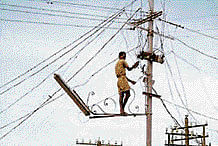
The Inter Governmental Panel on Climate Change (IPCC) has listed the potential impacts of global warming as: famines and droughts, worldwide drop in crops, risk of flooding and scarcity of fresh water supplies, sea level rise, huge impact on general health, etc. These impacts are projected to have a massive influence on the lives of millions of people living in tropical countries such as India.
Energy consumption is closely associated with substantial part of green house gas (GHG) emissions leading to global warming. According to the environment ministry, among the various forms of energy, electricity alone is responsible for about 38 per cent of all GHG emissions, and about 52 per cent of CO2 emissions. While fossil fuel burning for electricity generation is the major source of GHG emissions, about 65 per cent of the total installed electricity generating capacity in the country is based on fossil fuels.
India’s low per capita electricity consumption is being offered as the main argument in favour of larger carbon space for India. When we consider that for about 40 per cent of the population commercial energy is out of reach even after six decades of independence the gravity of the situation becomes clear. If we aim to provide energy security to a growing population in a business-as-usual scenario, the pollution level will be enormous.
As per Greenpeace’s projection, India’s contribution to global CO2 emissions will increase from about 1,126 million tonnes in 2003 to approximately 4,039 million tonnes in 2050, increasing its share in global emissions from 4.8 per cent to 8.7 per cent.
While it may appear logical that India should argue for common but differentiated responsibilities for each country to reduce country specific GHG emissions, its own record of energy consumption by two broad categories of citizens should be of grave concern.
Energy profligacy by the rich and lack of access to commercial energy for the poor should be of a major concern. India has a primary obligation to its own people to do all that is possible to minimise the impact of climate change. As per a Greenpeace report, ‘Hiding Behind the Poor’, much of India’s population, in the lowest income group, have per capita CO2 emissions of about 335 kg, while a small section of the population (the highest income group) have per capita CO2 emissions of about 1,500 kg.
The Planning Commission’s integrated energy policy has projected that “to sustain a growth rate of 8 per cent through 2031-32 and to meet the lifeline energy needs of the poor, India needs, at the very least, to increase power generation capacity to nearly 8,00,000 mw from the current 1,60,000 mw inclusive of all captive power plants.” In this context, it is important to note that more than 60 per cent of such additional capacity is projected to be fossil fuel-based. Successive governments have embarked on a major capacity addition drive based on fossil fuels and dams in the guise of providing electricity for all.
Sorry state of affairs
Greenpeace India undertook a study in 2009 to expose the electricity injustice within India. To compare the electricity supply scenario among the rural and urban populations, relevant data were sought from five different states of four regions. In each of these states, one tier A city, one tier B city, and three villages were chosen for the survey.
None of the 15 villages covered in the survey were found to have 100 per cent electrification. Even in those villages where official records indicate more than 50 per cent electrification of households, the supply is so poor that the per capita electricity consumption is abysmally low. Most of the villages covered in the survey have per capita electricity consumption of less than 100, which almost negates the very purpose of electrification. Most states consider one unit a day as the lifeline energy requirement for a family.
The worst part of such poor supply to the villages is that there is neither a regularity nor is it provided when the people need it most. Generally power supply is provided in the afternoon and late night, when it is not of much use for the villagers. Additionally, low voltage conditions and frequent interruptions make electrification a cruel joke on the villagers.
Whereas the demand and supply of electricity to towns and cities have been increasing at a tremendous rate, the rural areas are unable to meet even their basic needs for lighting and agriculture. The total installed generating capacity in the country has gone up from 58,012 mw in 1989 to 1,52,148 mw in 2009, a whopping 162 per cent increase.
National per capita electricity consumption has gone up from 283 kWH in 1992-93 to 429 in 2005-06, an increase of 52 per cent. But 40 per cent of the households, mostly in rural areas, have no access to electricity even in 2009.
A thorough analysis of the power sector provides real reasons for this gross neglect of rural areas. Huge inefficiencies in generation, transmission, distribution and utilisation are at the root of the larger problem. These inefficiencies alone, which are typical characteristics of a badly managed grid based centralised electricity generation system, amount to a total loss of about 25-40 per cent of the installed capacity. Few effective measures such as improving generating plant performance, reducing T&D losses, minimising wastage in usage, demand side management, energy conservation, have the potential to overcome the deficits.
The grid based centralised generation system has been considered by successive governments as a solution for faster economic growth and accelerated rural electrification, but in reality it helping largely to meet the ever growing electricity demand of only the urban population while adding hugely to pollution loads. Decentralised energy solutions are the right answers to provide quality access to electricity to the rural population.
(The writer is a power policy analyst)